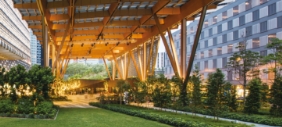2023.12.01 Functional

Relationship Between Paints and Sustainability
-Contributing to a Sustainable Future through Paint/Coating-
In recent years, natural disasters that normally occur only once in several decades have been occurring almost yearly. The number of large scale disasters is also increasing every year.
The concept of sustainability, now commonly heard, is not just a temporary trend, but can be regarded as an essential shift for the future of society. However, paints have both positive and negative effects on the environment and society.
So, what social responsibility can paint fulfill?
How can each of us contribute to a sustainable future through paints and coatings?
Choosing Environmentally Friendly Paints and Coatings
Environmentally friendly paints contribute to the reduction and alleviation of burdens on people, organisms, and the Earth's environment. Moreover, considering that certain chemical substances can be harmful to human health and the environment, the use of eco-friendly paints also helps decrease the potential harm to individuals.
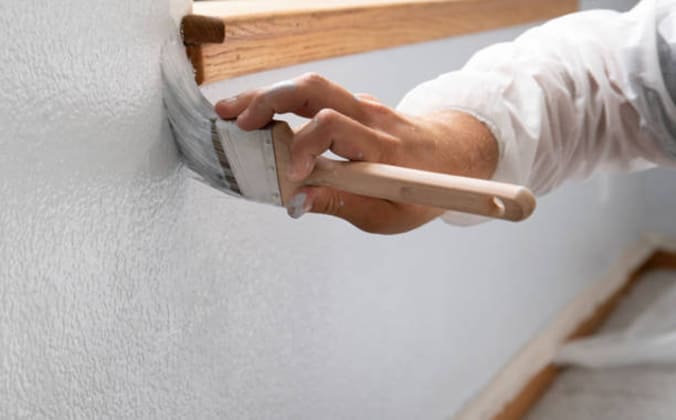
Types and Characteristics of Environmentally Friendly Paints (Japan Paint Manufacturers Association)
| Purpose | Functions | Type of paint/coating |
|---|---|---|
| Reduction of air pollution | Low VOC (Volatile Organic Compounds) | Water-based (VOC less than 1%) |
| Reduction of health and environmental impact | Reduction of harmful substances | Toluene/xylene-free Lead/chromium-free |
| Environmental improvement function | Anti-bacterial Anti-mould, anti-algae |
|
| Resource conservation | Longer lifespan | Highly durable, highly weather resistant |
| Energy saving | Energy reduction through paint film | Heat reflective |

Reduction of Air Pollution
There are two main types of paints/coatings: oil-based type and water-based type.
Oil-based paints contain a significant amount of VOC (Volatile Organic Compounds), which causes air pollution. From a sustainability perspective, it is important to use paints that either do not contain VOC or have minimal amounts.
In the past, most paints/coatings were oil-based. As the times change, the proportion of water-based paints has increased. Water-based paints either contain no VOC or have extremely low levels, thereby reducing the risk of air pollution. In terms of performance, there are many water-based highly functional paints/coatings.
Low-VOC products have less impact on indoor air quality, promoting a healthier living environment.
Key point!
The use of water-based paints and low-VOC paints contributes to the prevention of air pollution, making it a sustainable initiative that promotes both environmental conservation and human health.
Reducing Health and Environmental Impact
Regulations on hazardous substances that can have adverse effects on human health and the environment have gradually strengthened over time. For example, for lead-containing paints/coatings, regulations with global legal binding force have been implemented. Efforts towards the elimination are underway.
For interior, features such as anti-bacterial and anti-mould properties contribute to the improvement of living environment.
◆ Reducing Hazardous Substances
Toluene/xylene-free, lead/chromium-free, low odour
◆ Environmental Improvement Function
Dirt resistant paints, anti-bacterial paints, anti-mould/anti-algae paints
Key point!
In order to achieve a sustainable future, SKK is aiming to develop products that are friendly both to people and the environment, promoting health, comfort, safety, and a sense of security.


Resource Conservation
By using products with high durability and weather resistance such as silicone resin and fluorine resin based paints, the frequency of repainting can be reduced. This contributes to resource conservation and waste reduction. Simultaneously, it allows for cost reduction.
In the long run, it enables the long-term preservation of buildings, preventing excessive scrap-and-build practices.
Measures for Extending the Lifespan and Preventing Aging of Buildings
In order to reduce the environmental impact, it is important to focus on “prolonging the lifespan” and “aging countermeasures”. In this regard, the use of highly weather resistant products such as silicone resin based and fluorine resin based types for exterior can also contribute significantly.
Key point!
Choosing silicone or fluorine resin based products can extend the lifecycle of buildings, contributing to a sustainable future.

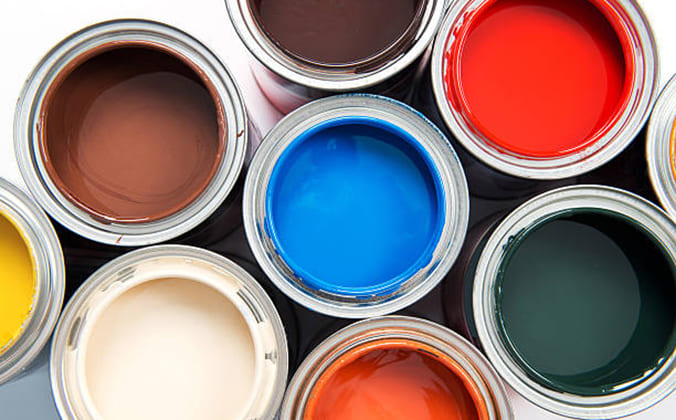
Waste Reduction and Recycling
Efforts to minimize waste generated during the manufacturing and application of paints, along with proper disposal, are crucial for building a sustainable future.
Furthermore, establishing recycling processes can reduce environmental impact of waste disposal.
Utilization of Renewable Raw Materials
To pursue sustainability, the use of renewable raw materials and resources becomes crucial. In fact, our non-combustible heat insulation material uses recycled styrene foam as aggregate.
Key point!
Pursuing sustainability in raw material selection, waste management and recycling.


Energy saving
From an energy efficiency standpoint, heat reflective coatings prove effective.
These coatings reflect the infrared rays in sunlight, suppressing the rise in temperature of roofs and exterior walls, thereby reducing air conditioning costs. By lowering energy costs, they also contribute to the reduction of greenhouse gas emissions.
Key point!
Heat reflective coatings can contribute to the prevention of global warming and the heat island countermeasures.
Promoting innovation and research
Through the development of new paint technologies and environmentally friendly paints/coatings, the paint industry can respond to sustainability and make significant contributions. Ongoing research, development and innovation lead to the development of more sustainable paint products.

In summary, sustainability in the realm of paints/coatings is closely related to the reduction of hazardous substances, the promotion of environmentally friendly durable/weather-resistant products, and the fulfillment of responsibility in manufacturing and waste management.
Through these efforts, paints can play a role in reducing environmental impact and effectively utilizing resources in a sustainable society.
Moreover, each of us can contribute to a sustainable future depending on how we select paints/coatings we use.
Trends in VOC Emissions from Paints (During Painting) (in Japan)
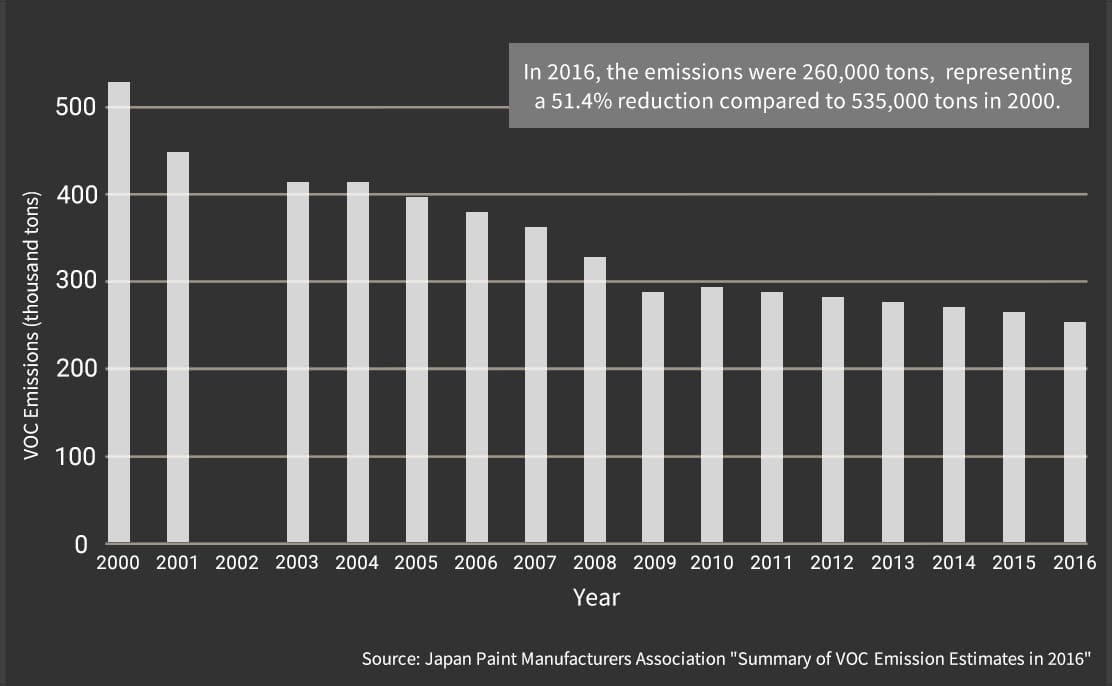
Reducing Lifecycle Costs with Highly Durable Paints
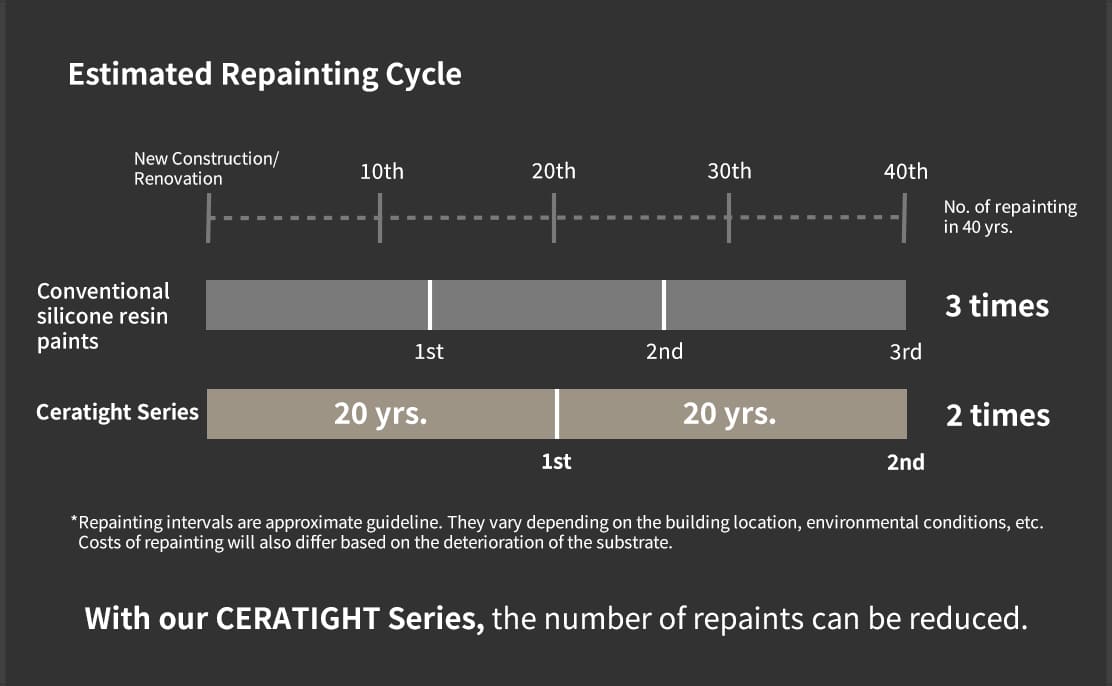
More Information
Products info by themesColumn categories
Access Ranking
Portal categories
Access Ranking

Functional
2024.02.28
Fair-Faced Concrete and Sustainability - Open up New Possibilities of Fair-Faced Concrete -

Material
2023.01.20
What are the advantages of expressing with a textured product instead of using natural stone?

Functional
2023.12.01
Relationship Between Paints and Sustainability

Functional
2024.01.29
Functionality and Sustainability 1 -Stop Dirt & Stains on Exterior Wall! -

Material
2024.04.03
Rich Colours and Designs Are the Key! -Sustainable Design-

Material
2023.12.11


